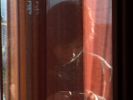Eye For Film >> Movies >> No Cow On The Ice (2015) Film Review
No Cow On The Ice
Reviewed by: Rebecca Naughten

Filmed over the course of several years, No Cow On The Ice (Ingen Ko På Isen) follows Galician filmmaker Eloy Domínguez Serén's emigration to Sweden and his attempts to translate his identity to this other culture. Two central strands are presented from the outset of the film - that this is emigration born out of economic necessity, indicated by the audio of a Swedish news report on the calamitous Spanish economy, and the centrality of language to our identity and how we negotiate our way in the world.
The latter is first illustrated by titles telling us the Swedish word and pronunciation for different things seen onscreen - water, dusk, moon. The naming of a thing is the first step towards comprehension - and in turn, of making yourself understood. Serén talks in English with his Swedish girlfriend Fathia but a creeping sense of alienation is apparent when he is shown taking part-time construction jobs (his family's business back in Galicia) but is unable to verbally interact with fellow workers because of the language barrier.

That he is occupying an undefined space - absent from home but not fully present in this new place because he does not yet have the ability to properly engage with it - is given form within the film through the changes in the style of narration. At the outset, the narration - for example, "I'm 2,637 kilometres from home" or "After one Batchelor's and one Master's degree, I'm the least skilled worker on this site" - is written rather than spoken; it appears onscreen as subtitles without Serén's vocal intonation of the words in any language. When inclement weather disrupts his employment on the building sites, the director applies himself to an intensive language course and we begin to to hear him speaking Swedish in conversation with other people onscreen, including audio of him explaining the footage we're watching to Fathia.
However, the narration style continues to be written rather spoken until he breaks up with Fathia - at which point it begins to be spoken by Serén in Swedish (almost no Spanish is heard within the film apart from a brief section when he returns home to visit his family). This change could be taken as a sign of his commitment to Sweden - he decided to stay, partly because he didn't want to leave at a point when his memories would be sad but also because he felt that he wasn't finished with the country. The remainder of the film is about him experiencing Sweden on his own terms, without the culture's many facets being filtered through someone else. The narration style for this part of the film is a manifestation of Serén's mastery of the other language and of his newfound ability to occupy a space in a foreign landscape.
Showing at Iberodocs 2016 as part of their Focus on First Works, Serén's feature debut is a thoughtful and personal meditation on language, identity and landscape - and a depiction of how we attempt to translate ourselves and regain our bearings when adrift in unfamiliar circumstances - and marks him out as a name to watch for in the future.
Reviewed on: 03 May 2016
















